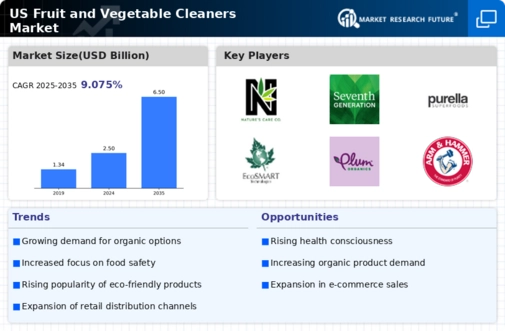The fruit vegetable-cleaners market in the US exhibits a dynamic competitive landscape, characterized by a blend of established players and emerging brands. Key growth drivers include increasing consumer awareness regarding food safety and hygiene, alongside a rising preference for eco-friendly products. Major companies such as Procter & Gamble (US), Unilever (GB), and Ecolab (US) are strategically positioned to leverage these trends. Procter & Gamble (US) focuses on innovation in product formulations, while Unilever (GB) emphasizes sustainability in its supply chain. Ecolab (US) is known for its expertise in sanitation solutions, which enhances its competitive edge in the market. Collectively, these strategies foster a competitive environment that prioritizes product efficacy and environmental responsibility.
In terms of business tactics, companies are increasingly localizing manufacturing to reduce supply chain vulnerabilities and enhance responsiveness to market demands. The competitive structure of the market appears moderately fragmented, with several key players holding substantial market shares. This fragmentation allows for a diverse range of products, catering to varying consumer preferences, while the influence of major players ensures a level of standardization in quality and safety.
In October 2025, Unilever (GB) announced a partnership with a leading agricultural technology firm to develop a new line of organic fruit and vegetable cleaners. This strategic move is likely to enhance Unilever's product portfolio, aligning with the growing consumer demand for organic and natural cleaning solutions. The collaboration may also facilitate innovation in product development, positioning Unilever favorably against competitors.
In September 2025, Ecolab (US) launched a new digital platform aimed at optimizing cleaning and sanitation processes for food service businesses. This initiative underscores Ecolab's commitment to integrating technology into its operations, potentially improving efficiency and customer satisfaction. The platform's introduction may also serve to strengthen Ecolab's market position by offering tailored solutions that address specific industry needs.
In August 2025, Procter & Gamble (US) expanded its product line with the introduction of a new biodegradable fruit and vegetable cleaner. This launch reflects the company's strategic focus on sustainability and innovation, catering to environmentally conscious consumers. The biodegradable aspect of the product may enhance its appeal, potentially driving market share growth in a competitive landscape increasingly focused on eco-friendly solutions.
As of November 2025, current trends in the fruit vegetable-cleaners market indicate a pronounced shift towards digitalization, sustainability, and the integration of artificial intelligence in product development and marketing strategies. Strategic alliances among companies are shaping the competitive landscape, fostering innovation and enhancing product offerings. Looking ahead, competitive differentiation is likely to evolve, with a greater emphasis on technological advancements and supply chain reliability, moving away from traditional price-based competition. Companies that prioritize innovation and sustainability may find themselves better positioned to capture market share in this evolving environment.
























Leave a Comment